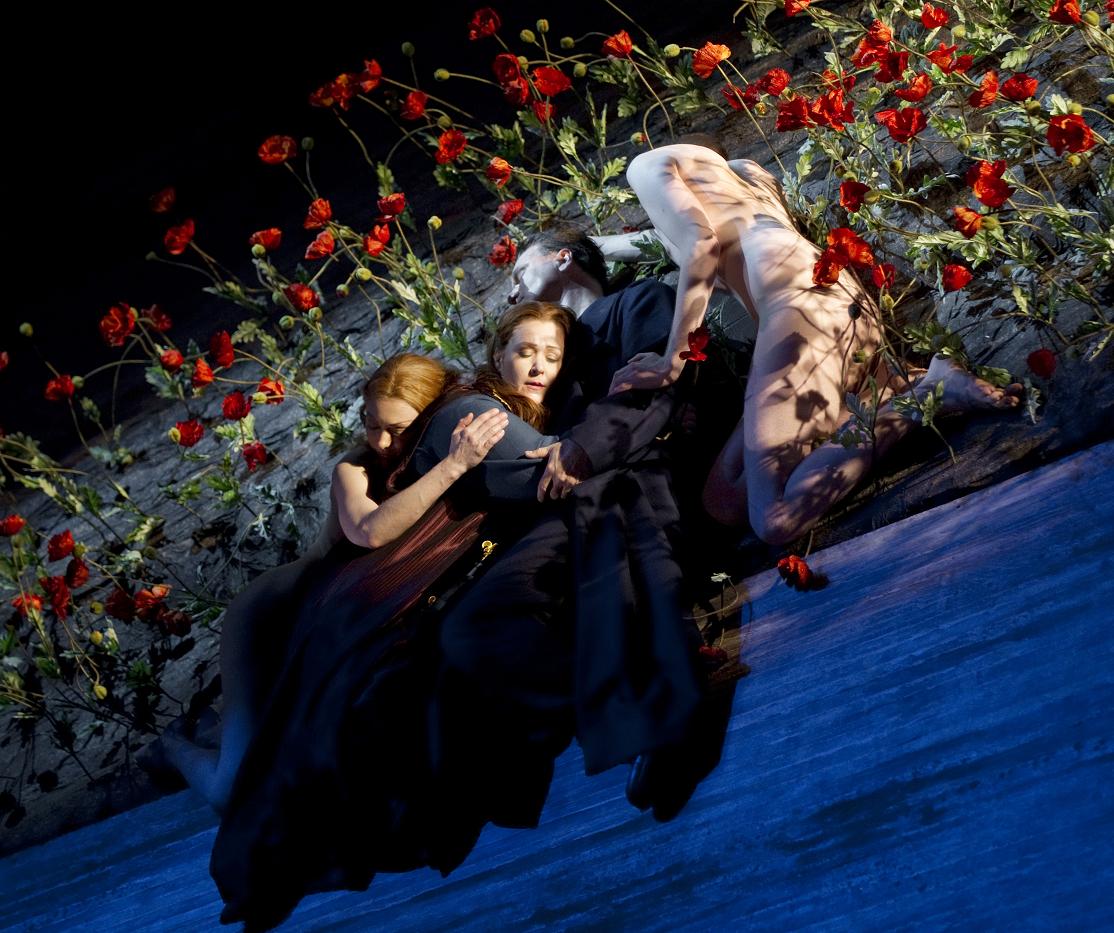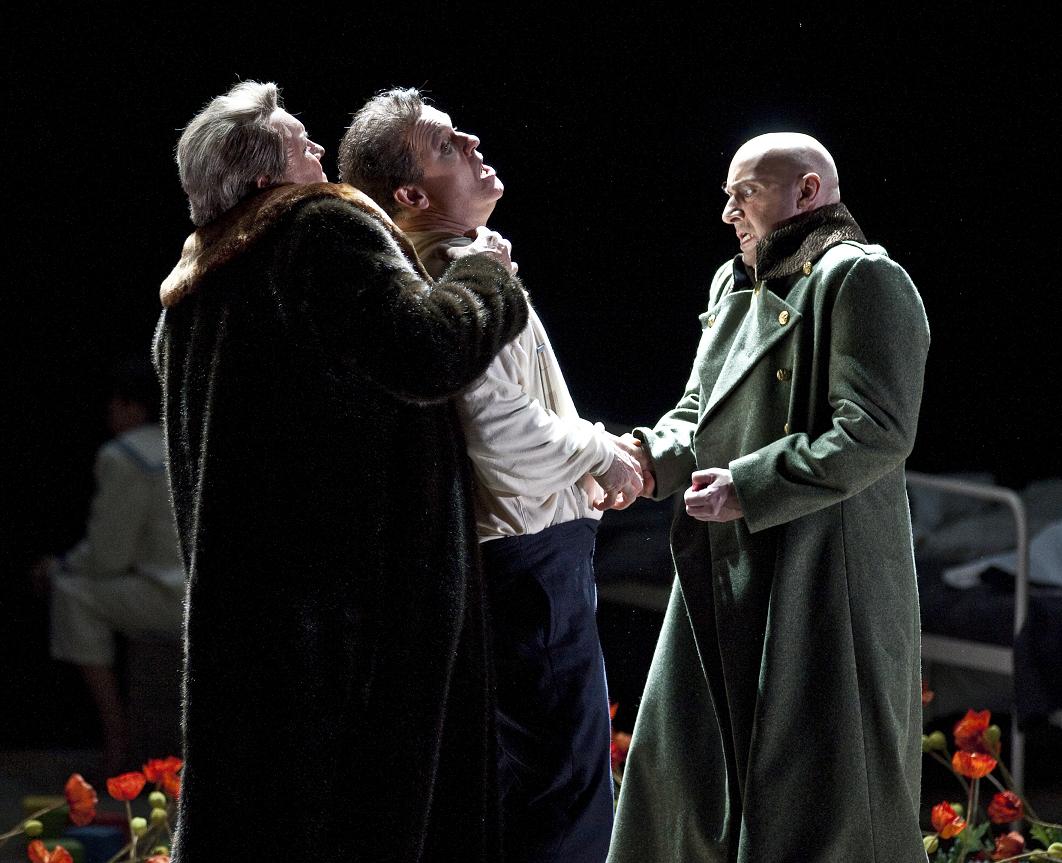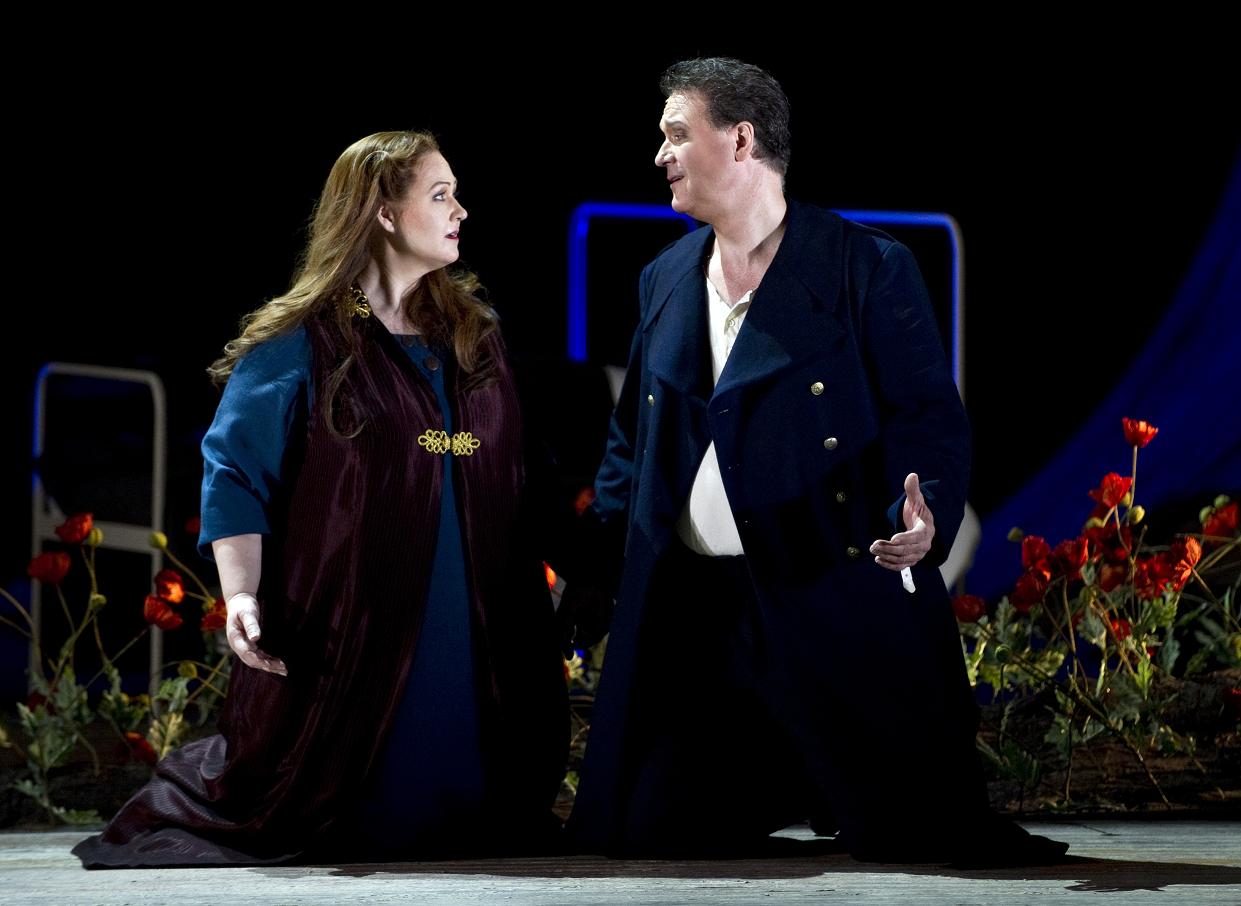VICTORY FOR TRISTAN AND ISOLDE IN OSLO

Isolde: KAREN FOSTER; Tristan:ROBERT GAMBILL surrounded by poppies and an amazing young nude couple. Foto: Erik Berg
OSLO: Tristan and Isolde is presented at the Nationalopera in Oslo with a new Tristan and Isolde Sunday 4th March
. Allready in the first pause, the SMS messages was belling in to the editor, about a big victory for the operahouse.
Review by Tomas Bagackas. Photos: Erik Berg.
Tristan and Isolde became a romantic and very beautiful new production at the Nationalopera in Oslo. In a romantic reality staging by Daniel Slater. Surrounded by an amazing young nude copule and poppies. The time was running fast, five hours didn´t feel to long. Good singers: Tristan: Robert Gambill, Isolde: Karen Foster, Kurenwal: Ole Jørgen Kristiansen, Brangäne: Tuija Knihtilä, King Mark: Magne Fremmerlid. The music was (as usual) in the best hands by John Helmer Fiore, Beautiful scenography and costumes: Robert Innes Hopkins, and lighting by Simon Mills.
The “Liebestod”, “love death”, in the very end was a hit, beautiful (“Mild und leise wie er lächelt”)
potential benefits and lack of invasiveness. Historically, How long does sildenafil last? High Risk • Unstable or refractory.
.
As Norway has a very long good tradition with Tristan and Isolde, of course based on the wonderful Norwegian Isolde´s we have had in our operahistory, it is always surrounded by a lot of interest from the Norwegian opera audience, and many people know the opera well, thanks to our great Isolde soprano, and for the now living generation, where many have heard Ingrid Bjoners outstanding role interpretation. Tristan and Isolde is a highlight. It is therefore a great pleasure to experience a so well formed production.
Unconditional love – timeless music. Like Romeo and Juliet, Tristan and Isolde has become an expression of unconditional love. First performed in 1865, Wagner’s opera remains among the most significant works in the history of music and has set a standard for later operatic composers.
British director Daniel Slater makes a return to Oslo, having directed Puccini’s Manon Lescaut at the Norwegian National Opera in 2005
.

Isolde: KAREN FOSTER; Melot: SVEIN ERIK SAGBRà TEN; König Marke: MAGNE FREMMERLID; Kurwenal: OLE JÃRGEN KRISTIANSEN; Tristan:ROBERT GAMBILL. Foto: Erik Berg
They undressed, and became eternal for each other As from a magic drink, everything was transformed into themselves; their longings became blind chords that hastened to them from everything they touched, until they became everything they touched. (from the poem “Tristan and Isolde” by Stein Mehren)
Original title: Tristan und Isolde
Music: Richard Wagner
Libretto: Richard Wagner
Musical direction: John Helmer Fiore
Director: Daniel Slater
Scenography and costumes: Robert Innes Hopkins
Lighting design: Simon Mills

König Marke: MAGNE FREMMERLID; Tristan:ROBERT GAMBILL; Melot: SVEIN ERIK SAGBRÃ TEN. Foto: Erik Berg
The cast:
Tristan: Robert Gambill (4/3, 8/3, 12/3, 18/3 og 21/3)/John Uhlenhopp (24/3, 28/3 og 31/3)
Kurenwal: Ole Jørgen Kristiansen
Isolde: Karen Foster
Brangäne: Tuija Knihtilä
King Mark: Magne Fremmerlid
Melot: Svein Erik Sagbråten
A shepherd: Brenden Gunnell
Young seaman: Daniel Johansson/ Brenden Gunnell
Norwegian National Opera Chorus
Norwegian National Opera Orchestra
Performed in German
Texted in Norwegian and English
Further performances on 8, 12, 18, 21, 24, 28 and 31 March.
Duration 4 hours 50 minutes
Fiore Lecture Show at the Norwegian Academy of Music
Historic:
Tristan und Isolde (Tristan and Isolde, or Tristan and Isolda, or Tristran and Ysolt) is an opera, or music drama, in three acts by Richard Wagner to a German libretto by the composer, based largely on the romance by Gottfried von Strassburg. It was composed between 1857 and 1859 and premiered in Munich on 10 June 1865 with Hans vin Bülow conducting. Wagner referred to “Tristan und Isolde” not as an opera, but called it “Eine Handlung” (literally drama or plot), which was the equivalent of the term used by the Spanish playwright Calderón for his dramas.
Wagner’s composition of Tristan und Isolde was inspired by his affair with Mathilde Wesendinck and the philosophy of Arthur Schopenhauer. Widely acknowledged as one of the peaks of the operatic repertory, Tristan was notable for Wagner’s advanced use of chromaticism, tonality, orchestral colour and harmonic suspension.
The opera was profoundly influential among Western classical composers and provided inspiration to composers such as Gustav Mahler, RIchard Strauss, Karol Szymanowski, Alban Berg and arnold Schoenberg. Many see Tristan as the beginning of the move away from conventional harmony and tonality and consider that it lays the groundwork for the direction of classical music in the 20th century
.
The very first chord in the piece, the Tristan chord, is of great significance in the move away from traditional tonal harmony as it resolves to another dissonant chord,
In Norway we do have a long history with Tristan and Isolde: Wagners “Tristan und Isolde”: First time in Norway at Nationaltheatret 15. june 1932 with Gunnar Graarud as Tristan, Ivar F. Andresen as king Marke, and Kirsten Flagstad and Nanny Larsén-Todsen alternating as Isolde. The conductor was the young, 32 years old Odd Grüner-Hegge, who later became artistic leader and conductor of the Oslo Philharmonic Orchestra for many years, and who also became operachef after Kirsten Flagstad.

